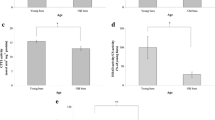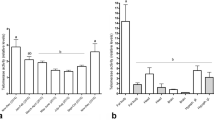Abstract
Honeybees (Apis mellifera) are an attractive model system for studying aging. However, the aging level of worker honeybees from the field hive is in dispute. To eliminate the influence of task performance and confirm the relationship between chronological age and aging, we reared newly emerged workers in a thermostat at 34°C throughout their lives. A survivorship curve was obtained, indicating that workers can be reared away from the field hive, and the only difference between these workers is age. To confirm that these workers can be used for aging studies, we assayed age-related molecules in the trophocytes and fat cells of young and old workers. Old workers expressed more senescence-associated β-galactosidase, lipofuscin granules, lipid peroxidation, and protein oxidation than young workers. Furthermore, cellular energy metabolism molecules were also assayed. Old workers exhibited less ATP concentration, β-oxidation, and microtubule-associated protein light chain 3 (LC3) than young workers. These results demonstrate that honeybees reared in a thermostatic chamber can be used for aging studies and cellular energy metabolism in the trophocytes and fat cells of workers changes with advancing age.






Similar content being viewed by others
References
Almeida H, Magalhães MC, Magalhães MM (1998) Age-related changes in lipid peroxidation products in rat adrenal gland. Age 21:119–121
Baur JA, Pearson KJ, Price NL, Jamieson HA, Lerin C, Kalra A, Prabhu VV, Allard JS, Lopez-Lluch G, Lewis K, Pistell PJ, Poosala S, Becker KG, Boss O, Gwinn D, Wang M, Ramaswamy S, Fishbein KW, Spencer RG, Lakatta EG, Couteur DL, Shaw RJ, Navas P, Puigserver P, Ingram DK, de Cabo R, Sinclair DA (2006) Resveratrol improves health and survival of mice on a high-calorie diet. Nature 444:337–342
Brunk UT, Terman A (2002) Lipofuscin: mechanisms of age-related accumulation and influence on cell functions. Free Radic Biol Med 33:611–619
Collins AM, Williams V, Evans JD (2004) Sperm storage and antioxidative enzyme expression in the honey bee, Apis mellifera. Insect Mol Biol 13:141–146
Cordiner S, Egginton S (1997) Effects of seasonal temperature acclimatization on muscle metabolism in rainbow trout, Oncorhynchus mykiss. Fish Physiol Biochem 16:333–343
Corona M, Hughes KA, Weaver DB, Robinson GE (2005) Gene expression patterns associated with queen honey bee longevity. Mech Ageing Dev 6:1230–1238
Cuervo AM, Bergamini E, Brunk UT, Drӧge W, Ffrench M, Terman A (2005) Autophagy and aging: the importance of maintaining “clean” cells. Autophagy 1:131–140
Dimri GP, Lee X, Basile G, Acosta M, Scott G, Roskelley C, Medrano EE, Linskens M, Rubelj I, Pereira Smith O, Peacocke M, Campisi J (1995) A biomarker that identifies senescent human cells in culture and in aging skin in vivo. Proc Natl Acad Sci U S A 92:9363–9367
Draper HH, Hadley M (1990) Malondialdehyde determination as index of lipid peroxidation. Methods Enzymol 86:421–431
Genade T, Benedetti M, Terzibasi E, Roncaglia P, Valenzano DR, Cattaneo A, Cellerino A (2005) Annual fishes of the genus Nothobranchius as a model system for aging research. Aging Cell 4:223–233
Grotewiel MS, Martin I, Bhandari P, Cook-Wiens E (2005) Functional senescence in Drosophila melanogaster. Ageing Res Rev 4:372–397
Guarente L (1997) Link between aging and the nucleolus. Genes Dev 11:2449–2455
Herrera M, Jagadeeswaran P (2004) Annual fish as a genetic model for aging. J Gerontol A Biol Sci Med Sci 59:101–107
Hsieh YS, Hsu CY (2011) Honeybee trophocytes and fat cells as target cells for cellular senescence studies. Exp Gerontol 46:233–240
Hsu CY, Chiu YC (2009) Ambient temperature influences aging in an annual fish (Nothobranchius rachovii). Aging Cell 8:726–737
Hsu CY, Ko FY, Li CW, Fann K, Lue JT (2007) Magnetoreception system in honeybees (Apis mellifera). PLoS One 2(4):e395. doi:10.1371/journal.pone.0000395
Hsu CY, Chiu YC, Hsu WL, Chan YP (2008) Age-related markers assayed at different developmental stages of the annual fish Nothobranchius rachovii. J Gerontol A Biol Sci Med Sci 63A:1267–1276
Jemielity S, Keller L (2007) Aging: a young mind in old bees. Curr Biol 17:R294–R295
Kadowaki M, Karim MR, Carpi A, Miotto G (2006) Nutrient control of macroautophagy in mammalian cells. Mol Aspects Med 27:426–443
Kelley D, He J, Menshikova E, Ritov V (2002) Dysfunction of mitochondria in human skeletal muscle in type 2 diabetes. Diabetes 51:2944–2950
Kishi S, Uchiyama J, Baughman A, Goto T, Lin M, Tsai S (2003) The zebrafish as a vertebrate model of functional aging and very gradual senescence. Exp Gerontol 38:777–786
Kostyak JC, Kris-Etherton P, Bagshaw D, DeLany JP, Farrell PA (2007) Relative fat oxidation is higher in children than adults. Nutr J 6:19
Kurz DJ, Decary S, Hong Y, Erusalimsky JD (2000) Senescence-associated β-galactosidase reflects an increase in lysosomal mass during replicative ageing of human endothelial cells. J Cell Sci 113:3613–3622
Levadoux E, Morio B, Montaurier C, Puissant V, Boirie Y, Fellmann N, Picard B, Rousset P, Beaufrere B, Ritz P (2001) Reduced whole-body fat oxidation in women and in the elderly. Int J Obes Relat Metab Disord 25:39–44
Lum JJ, DeBerardinis RJ, Thompson CB (2005) Autophagy in metazoans: cell survival in the land of plenty. Nat Rev Mol Cell Biol 6:439–448
McMullen CA, Ferry AL, Gamboa JL, Andrade FH, Dupont-Versteegden EE (2009) Age-related changes of cell death pathways in rat extraocular muscle. Exp Gerontol 44:420–425
Mecocci P, Fano G, Fulle S, MacGarvey U, Shinobu L, Polidori MC, Cherubini A, Vecchirt J, Senin U, Beal MF (1999) Age-dependent increase in oxidative damage to DNA, lipids, and proteins in human skeletal muscle. Free Radic Biol Med 26:303–308
Nakano M, Oenzil F, Mizuno T, Gotoh S (1995) Age-related changes in the lipofuscin accumulation of brain and heart. Gerontology 41:69–79
Neukirch A (1982) Dependence of the life span of the honeybee (Apis mellifera) upon flight performance and energy consumption. J Comp Physiol 146:35–40
Petersen KF, Dufour S, Befroy D, Garcia R, Shulman GI (2004) Impaired mitochondrial activity in the insulin-resistant offspring of patients with type 2 diabetes. N Engl J Med 350:664–671
Remolina SC, Hafez DM, Robinson GE, Hughes KA (2007) Senescence in the worker honey bee Apis mellifera. J Insect Physiol 53:1027–1033
Rueppell O, Bachelier C, Fondrk MK, Page RE (2007a) Regulation of life history determines lifespan of worker honey bees (Apis mellifera L.). Exp Gerontol 42:1020–1032
Rueppell O, Christine S, Mulcrone C, Groves L (2007b) Aging without functional senescence in honey bee workers. Curr Biol 17:R274–R275
Schippers MP, Dukas R, Smith RW, Wang J, Smolen K, McClelland GB (2006) Lifetime performance in foraging honeybees: behaviour and physiology. J Exp Biol 209:3828–3836
Schippers MP, Dukas R, McClelland GB (2010) Lifetime- and caste-specific changes in flight metabolic rate and muscle biochemistry of honeybees, Apis mellifera. J Comp Physiol B 180:45–55
Seehuus SC, Krekling T, Amdam GV (2006a) Cellular senescence in honey bee brain is largely independent of chronological age. Exp Gerontol 41:1117–1125
Seehuus SC, Norberg K, Gimsa U, Krekling T, Amdam GV (2006b) Reproductive protein protects functionally sterile honey bee workers from oxidative stress. Proc Natl Acad Sci U S A 103:962–967
Sohal RS, Agarwal S, Dubey A, Orr WC (1993) Protein oxidative damage is associated with life expectancy of houseflies. Proc Natl Acad Sci U S A 90:7255–7259
Taneike M, Yamaguchi O, Nakai A, Hikoso S, Takeda T, Mizote I, Oka T, Tamai T, Oyabu J, Murakawa T, Nishida K, Shimizu T, Hori M, Komuro I, Shirasawa T, Mizushima N, Otsu K (2010) Inhibition of autophagy in the heart induces age-related cardiomyopathy. Autophagy 6:600–606
Terman A, Brunk UT (2004) Lipofuscin. Int J Biochem Cell Biol 36:1400–1404
Thibeault M, Blier PU, Guderley H (1997) Seasonal variation of muscle metabolism organization in rainbow trout (Oncorhynchus mykiss). Fish Physiol Biochem 16:139–155
van der Loo B, Fenton MJ, Erusalimsky JD (1998) Cytochemical detection of a senescence-associated b-galactosidase in endothelial and smooth muscle cells from human and rabbit blood vessels. Exp Cell Res 241:309–315
Weirich GF, Collins AM, Williams VP (2002) Antioxidant enzymes in the honey bee, Apis mellifera. Apidologie 33:3–14
Welis-Knecht MC, Huggins TG, Dyer G, Thorpe SR, Baynes JW (1993) Oxidized amino acids in lens protein with age. J Biol Chem 268:12348–12352
Williams JB, Roberts SP, Elekonich MM (2008) Age and natural metabolically intensive behavior affect oxidative stress and antioxidant mechanisms. Exp Gerontol 43:538–549
Acknowledgments
This work was supported by CMRPD 170361 grant from Chang Gung Memorial Hospital, Taiwan. We thank Scott C. Schuyler for critically reading the manuscript.
Author information
Authors and Affiliations
Corresponding author
About this article
Cite this article
Hsu, CY., Chan, YP. The use of honeybees reared in a thermostatic chamber for aging studies. AGE 35, 149–158 (2013). https://doi.org/10.1007/s11357-011-9344-z
Received:
Accepted:
Published:
Issue Date:
DOI: https://doi.org/10.1007/s11357-011-9344-z




